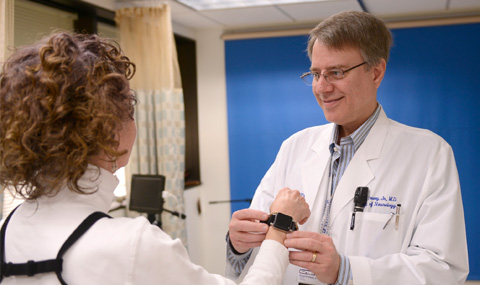.gif) VIARTIS
|
||||||||||||
|
PARKINSON'S DISEASE NEWS |
||||||||||||
|
|
Parkinson's Disease News covers all significant new research, reports, books, and resources concerning Parkinson's Disease. Articles are chosen on the basis of their medical significance or potential interest. Our overwhelming priority is the facts, regardless of whether they contradict prevailing views or vested interests. Analysis and further information are provided either to explain the background or implications, or to balance misleading claims. If you notice errors or inadequacies, or dispute what is written, or want to propose articles, please e-mail [email protected].
18th March 2016 - New research MONITORING TECHNOLOGIES TO ASSESS PARKINSON'S DISEASE
Researchers carried out a systematic review in order to (1) list, (2) compare and (3) classify technological-based devices used to measure motor function in people with Parkinson's Disease into three groups : wearable, non-wearable and hybrid devices. A systematic search of the PubMed database resulted in the inclusion of 168 studies.
Mobility Lab System (APDM) - A watch-sized device consisting of up to six sensors that enables the registration of different outcomes such as, postural sway, lower limb gait, postural transitions, upper limb gait, and trunk measures. Go to the web site Physilog - An analysis method that uses body-attached gyroscopes to assess spatio-temporal parameters of gait, sway, physical activity, tremor and bradykinesia.Minimal attachment sites are used and no calibration is needed. Go to the web site StepWatch 3 - The StepWatch 3 (SAM) is a step activity monitor used to capture differences in ambulatory activity according to age and functional limitation. The StepWatch (SAM) is the size of a pager and attaches to the ankle. Go to the web site TriTrac RT3 Triaxial accelerometer - The TriTrac RT3 may be suitable for sustained tracking of free-living physical activity in the home environment. It is small, capable of collecting and storing data in one-minute epochs for 21 days. Go to the web site McRoberts DynaPort - The DynaPort MiniMod Hybrid combines acceleration sensors and gyroscopes with six channels that assess the individual’s movement at 100Hz each. Go to the web site Axivity (AX3) - The Axivity (AX3) is a three-axis accelerometer that has a non-volatile flash memory chip linked by a USB-enabled microcontroller. Inside the sealed polycarbonate puck is a temperature sensor, ambient light sensor, and real time clock and lithium polymer battery. Go to the web site Within the non-wearable devices group, those classified as recommended : Nintendo Wii Balance Board - Nintendo Wii Balance Board is a commonly used accessory for video game consoles. It is considered a cheap, widespread, clinimetric robust device that can be used to measure postural instability in PD patients. Go to the web site GAITRite gait analysis system - The GAITRite system is an electronic pathway that contains pressure sensitive sensors arranged in a grid-like pattern. The carpet is portable and can be rolled up for transportation. It is used for laboratory evaluation and provides information regarding several gait parameters, such as walking speed, cadence and step length. Go to the web site Within the hybrid devices group the only one classified as recommended was the : Kinesia system - Kinesia integrates accelerometers and gyroscopes in a compact patient-worn unit to capture kinematic movement disorder features. The sensor component of the device is mounted on a ring, which fits on a finger. Go to the web site Reference : Journal of Neuroengineering and Rehabilitation [2016] 13 (1) : 24 (C.Godinho, J.Domingos, G.Cunha, A.T.Santos, R.M.Fernandes, D.Abreu, N.Gonçalves, H.Matthews, T.Isaacs, J.Duffen, A.Al-Jawad, F.Larsen, A.Serrano, P.Weber, A.Thoms, S.Sollinger, H. Graessner, W.Maetzler, J.J.Ferreira) Go to the Complete study For more news go to Parkinson's Disease News
|
|
||||||||||
.gif) |
||||||||||||
| ©2006-2016 Viartis | ||||||||||||
| 2016-03-18 15:57:40 | ||||||||||||
| [email protected] | ||||||||||||









 These
studies were grouped based on the type of device used. For each device they
reviewed the availability, use, reliability, validity, and sensitivity to
change. 73 devices were identified. Of these, 22 were wearable, 38 were non-
wearable, and 13 were hybrid devices. In accordance with their
classification, 9 devices were recommended, 34 were suggested, and 30
devices were classified as listed.
These
studies were grouped based on the type of device used. For each device they
reviewed the availability, use, reliability, validity, and sensitivity to
change. 73 devices were identified. Of these, 22 were wearable, 38 were non-
wearable, and 13 were hybrid devices. In accordance with their
classification, 9 devices were recommended, 34 were suggested, and 30
devices were classified as listed.  E-MAIL NOTIFICATION : If you would like to be
notified by e-mail when any new articles are added to Parkinson's Disease News, please merely
e-mail
E-MAIL NOTIFICATION : If you would like to be
notified by e-mail when any new articles are added to Parkinson's Disease News, please merely
e-mail
